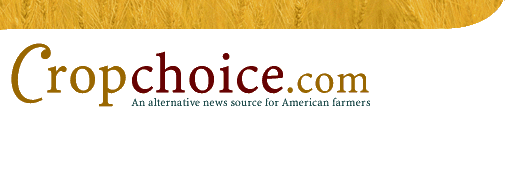by Paul Beingessner
Canadian farmer, writer
(Tuesday, Dec. 23, 2003 -- CropChoice guest commentary) -- In a recent editorial in the Manitoba Co-operator, hog farmer Rolf
Penner contributes his two bits in support of GM crops. In doing so,
Penner attacks those who believe the creators and beneficiaries of GM
crops should be responsible for the damage they cause to farmers who do
not grow them. Penner argues that GM crops are no different than
non-GM. They look, smell and taste the same and, he claims, pose no
health risks. Cross-contamination between GM and non-GM crops produces
changes that are really of no consequence. Penner compares it to someone
turning around in your driveway. Yes, they were on your property without
permission, but they did you no harm.
As to the health issues, he says science has shown there is no risk in
consuming GM plants or seeds. This is untrue. Science most certainly has
not proven there is no risk to eating GM crops since science has done
virtually no direct testing of that hypothesis.
The claim that GM foods are safe is based on the doctrine of
"substantial equivalence". This doctrine holds that since GM foods
appear to be the same as non-GM for a certain set of characteristics,
they are deemed to be the same for purposes of regulation. The trouble
with that view is it depends on how comprehensive the set of
characteristics that are measured is.
For example, in 1989, a company call Showa Denko K.K. marketed
tryptophan in the United States that was produced by genetically
engineered bacteria. It was sold as a nutritional supplement. Within
three months of hitting the market, the tryptophan made thousands of
people ill, permanently disabled 1500 and killed 37. Since the
measurements made on this product showed it was as pure as conventional
tryptophan, it had been deemed substantially equivalent. The measurement
did not look at the 0.01 percent toxin that was produced by the
bacteria, and that did all the damage.
Genetically engineered foods classified as substantially equivalent are
spared from extensive safety testing on the assumption that they are no
more dangerous than the corresponding non-GM food. Thus, GM foods have
not been subject to long term animal or human testing before approval.
So, as I said, they are not proven to cause harm, (tryptophan aside) but
neither are they proven safe.
Penner then deals with the issue of market and customer resistance by
blaming organic growers for it. He quotes Alex Avery from the Hudson
Institute who says the "organic community" and "radical
environmentalists" are to blame for customer resistance since they have
created an environment of fear by rejecting science. De facto, then,
organic farmers should not be compensated for damage from GM
contamination since they themselves are to blame for customers not
wanting it.
It is a bold leap of logic, based on the claim that science, and hence
all scientists, are united in the position that GM foods are harmless.
Nothing could be further from the truth. Yes, some scientists hold that
position. Other scientists, folks with Ph.D.'s in molecular biology and
a range of other fields, have a different opinion. (In Penner's and
Avery's analysis, though, anyone opposing GM foods automatically loses
their scientific credentials and becomes a lunatic fringe organic farmer
or a tree-hugging radical environmentalist.) Were Alex Avery honest, he
would say that the scientists are divided and the science inconclusive.
Consumers appear to have judged the science they know and come to a
certain conclusion. Whether this conclusion is based on a preponderance
of scientific evidence, I do not know. Neither does Rolf Penner, since
he hasn't done an exhaustive search of the literature. Nor, apparently,
does Alex Avery, despite his grandiose claims.
The whole GM issue - substantial equivalence, consumer resistance, gene
patenting and responsibility for damage - reminds me of a situation that
could very well occur with livestock. Suppose I have a herd of purebred
Angus cattle and I market my beef as a branded product. Because it is
just so darn good I get a premium for my beef. Suppose my neighbour has
a fence-crashing bull that continually breaks through the fence to
"cross-pollinate" with my cows. By all measures, the beef from these
cross-pollinated calves is "substantially equivalent" to that of my
purebreds. But my customers will not pay the premium because they want
my branded product. Do I have any claim against my neighbour if he fails
to deal with his fence-busting bull? Is it my job to put up a fence that
will hold elephants so my neighbour can have any type of bull he wants?
Or is it his job?
What about fence-busting pollen, or gene transmission by other means? If
I sell Roundup Ready wheat, knowing that normal farming practices will
eventually spread it throughout all varieties, (remember that many
foundation seedstocks of canola contain Roundup Ready genes) am I
responsible for its wanderings?
Indeed, Monsanto goes beyond even that analogy. In the Percy Schmeiser
case, Monsanto claimed that all canola plants with Roundup Ready genes
belong to Monsanto, no matter where they are growing or how they got
there. And they won!
Will my neighbor be able to claim that all my calves bearing the genes
of his bull belong rightfully to him? It appears he might be able to in
Canada if he just patents one of his bull's genes. After all, Monsanto
only holds a patent on a gene, not on the whole canola plant.
(c) Paul Beingessner (306) 868-4734 phone 868-2009 fax
beingessner@sasktel.net



